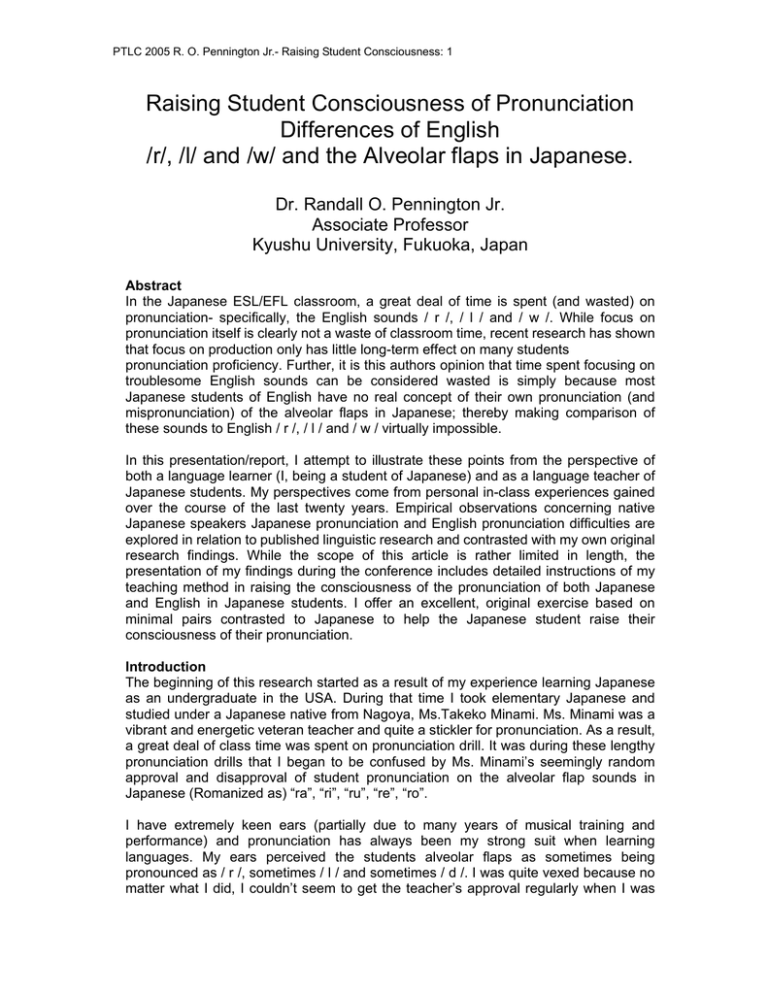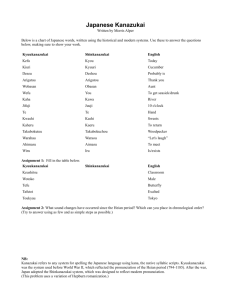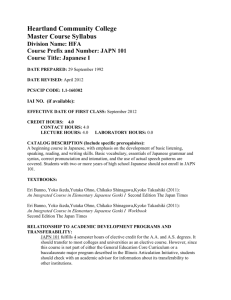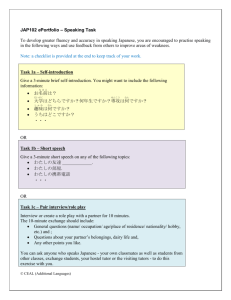Raising Student Consciousness of Pronunciation Differences of English
advertisement

PTLC 2005 R. O. Pennington Jr.- Raising Student Consciousness: 1 Raising Student Consciousness of Pronunciation Differences of English /r/, /l/ and /w/ and the Alveolar flaps in Japanese. Dr. Randall O. Pennington Jr. Associate Professor Kyushu University, Fukuoka, Japan Abstract In the Japanese ESL/EFL classroom, a great deal of time is spent (and wasted) on pronunciation- specifically, the English sounds / r /, / l / and / w /. While focus on pronunciation itself is clearly not a waste of classroom time, recent research has shown that focus on production only has little long-term effect on many students pronunciation proficiency. Further, it is this authors opinion that time spent focusing on troublesome English sounds can be considered wasted is simply because most Japanese students of English have no real concept of their own pronunciation (and mispronunciation) of the alveolar flaps in Japanese; thereby making comparison of these sounds to English / r /, / l / and / w / virtually impossible. In this presentation/report, I attempt to illustrate these points from the perspective of both a language learner (I, being a student of Japanese) and as a language teacher of Japanese students. My perspectives come from personal in-class experiences gained over the course of the last twenty years. Empirical observations concerning native Japanese speakers Japanese pronunciation and English pronunciation difficulties are explored in relation to published linguistic research and contrasted with my own original research findings. While the scope of this article is rather limited in length, the presentation of my findings during the conference includes detailed instructions of my teaching method in raising the consciousness of the pronunciation of both Japanese and English in Japanese students. I offer an excellent, original exercise based on minimal pairs contrasted to Japanese to help the Japanese student raise their consciousness of their pronunciation. Introduction The beginning of this research started as a result of my experience learning Japanese as an undergraduate in the USA. During that time I took elementary Japanese and studied under a Japanese native from Nagoya, Ms.Takeko Minami. Ms. Minami was a vibrant and energetic veteran teacher and quite a stickler for pronunciation. As a result, a great deal of class time was spent on pronunciation drill. It was during these lengthy pronunciation drills that I began to be confused by Ms. Minami’s seemingly random approval and disapproval of student pronunciation on the alveolar flap sounds in Japanese (Romanized as) “ra”, “ri”, “ru”, “re”, “ro”. I have extremely keen ears (partially due to many years of musical training and performance) and pronunciation has always been my strong suit when learning languages. My ears perceived the students alveolar flaps as sometimes being pronounced as / r /, sometimes / l / and sometimes / d /. I was quite vexed because no matter what I did, I couldn’t seem to get the teacher’s approval regularly when I was PTLC 2005 R. O. Pennington Jr.- Raising Student Consciousness: 2 called on to pronounce these alveolar flaps. The student preceding me would clearly use a / l / pronunciation, be given approval and then I would be called to produce the same sound and I would indeed produce the same / l / pronunciation and be told it was wrong. Also it should be noted that our instructor’s normally very lucid descriptions were somewhat less than enlightening when she was queried on how to produce the sounds correctly. I approached several students and they perceived the same apparent random nature of the approval by the teacher. Soon the whole class was talking about this issue and as a group and we decided to try an experiment. In the following class we students all intentionally used / l / pronunciation when drilled on alveolar flaps. Once again, our teacher approved of some and disapproved of others. I came to the conclusion that the lack of clear explanation of the production of these sounds and the inconsistent approval of a variety of different pronunciations was due to some inability on Mrs. Minami’s behalf to perceive the differences or that, in fact, her own pronunciation was not consistent on these particular syllables. This conclusion seemed quite logical as tradition dictates that perception precedes production however, to note here that Sheldon and Strange (1982) found evidence that in the case of English / l / and / r / that speech production can precede speech perception. Not an isolated case Soon after graduation I arrived in Japan to work as an English conversation teacher. Very soon after my arrival I began to immediately realize that my experience with my former Japanese teacher at university was far from an isolated case. While I monitored Japanese conversation and continued on with my private study of Japanese, I quickly began to perceive that the alveolar flaps were routinely (and completely unknowingly) mispronounced by native speakers of Japanese. That is, the native Japanese speakers I monitored did not flip their tongues across the alveolar ridge. The most commonly heard mispronunciations resulted in / l / (which is a sound that does not naturally exist in Japanese) and / d /. On rare occasions I could discern a weak / r /. The phenomenon of some correct / r / (and / l /) production by Japanese learners Was discovered by Goto (1971) and later rediscovered by Sheldon and Strange (1982). In essence, Goto found that Japanese learners could produce / r / and / l / more accurately than they could perceive those sounds in their own speech or in others speech. Musical evidence Japanese pop music is decidedly western. While the occasional English word or phrase will appear in the lyrics, it is mostly sung in Japanese. I quickly noticed that Japanese singers were not using Japanese pronunciation when singing the alveolar flaps “ra”, “ri”, “ru”, “re”, “ro”. The use of / l / was most obvious to this researcher. So, doubting that such widespread mispronunciation of Japnese could go unnoticed by Japanese native speakers, I immediately started playing Japanese music CD’s with these apparent alveolar flap mispronunciations to my students who were most proficient in English pronunciation. Without telling them my purpose, I asked them to pay attention lyrics with words containing one of the alveolar flaps. PTLC 2005 R. O. Pennington Jr.- Raising Student Consciousness: 3 One such example was the then popular song “Kawa No Nagare No You Ni” by Japanese singing legend, Misora Hibari. In the haunting chorus of this song she repeatedly croons, “kawa-no-na-ga- / ley / - no-you-ni” (translated: Like a flowing river…). I played this song to 50 students, seventeen of which were “high level” speakers and not one single person perceived any pronunciation mistake in Miss Hibari’s “na-ga / ley /”. Clueless about their own tongue movement Further classroom investigation proved that the students had absolutely no idea that they were sometimes producing English / l / and English / d / rather than the alveolar flaps. This naturally led to greater confusion when the students were trying to master English / l / or / r / pronunciation. Since it became painfully clear that the majority of the Japanese students studied had at least 2 errant alveolar flap pronunciations on average, then it also led to the logical conclusion that if the student cannot be aware of their own mispronunciation in Japanese, that it no doubt leads to an even greater likelihood that the student will never be able to master the English / r / or / l / simply because the student has no solid pronunciation in Japanese to compare it to. An American teaches Japanese people Japanese pronunciation I decided that before any instruction of English / r / or / l / could occur, the students needed to be made aware of the widely divergent pronunciation problems that existed in the alveolar flaps amongst Japanese speakers. Using sammys of the alveolar flap drawn on the blackboard and small hand held mirrors for the students, I intensively drilled the students in the correct pronunciation of the alveolar flaps, much in the same way my previous Japanese teacher had. Following that I introduced the sammy for English / l / and showed them the differences in tongue position. Then I introduced a minimal pair exercise in which the students were asked to use Japanese pronunciation for the alveolar flap and then use English for the / l /. After a few minutes of constant pronunciation practice, feedback from me and intense scrutiny of both the students tongue movements and the sammys for the two types of pronunciation, I expand the comparison to encompass / r / and / w /. Minimal pairs are used again. Finally the exercise ends in a comparison of alveolar flaps, / l /, / r / and / w /. Concisely put, subsequent testing revealed a significant increase in the ability to distinguish the different English sound from the Japanese alveolar flaps. Conclusion While space doesn’t permit detailed elaboration here, I can summarize my findings, by saying that due to the widespread mispronunciation of the alveolar flaps in Japanese, Japanese learners of English must be made aware of their own possibly errant pronunciation of the alveolar flaps before they attempt to study English pronunciation. The effective use of mirrors and sammys has proven effective in my classroom to facilitate better pronunciation in some cases, and generally higher awareness of the pronunciation differences that exist amongst Japanese natives. This, in turn, serves as a springboard for the comparison of the troublesome English / l / and / r /. PTLC 2005 R. O. Pennington Jr.- Raising Student Consciousness: 4 My method of comparing / drilling and thereby enabling the student to raise his/her consciousness level of pronunciation has resulted in better listening comprehension for the students studied and has also been reported to have unlocked the secret to better English pronunciation (according to many student reports) for my students. Bibliography Sheldon, A. and Strange, W. (1982) The acquisition of /r/ and /l/ by Japanese learners of English: Evidence that speech production can precede speech perception. Applied Psycholinguistics (3) Oxford University Press.







